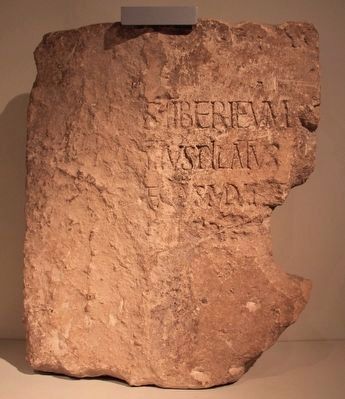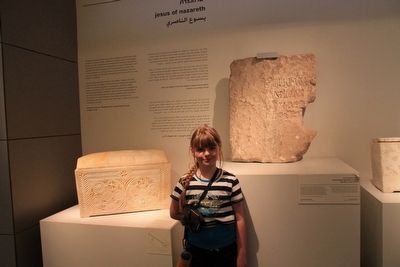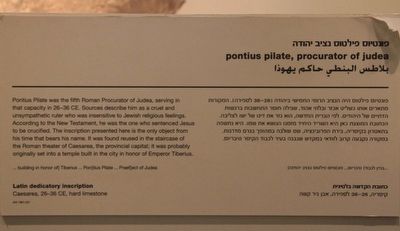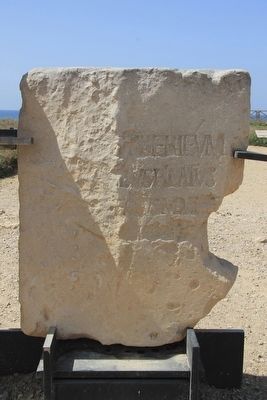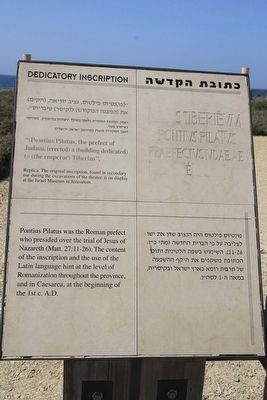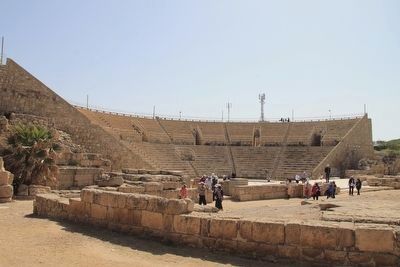Jerusalem, Jerusalem District, Israel — The Middle East (West Asia)
Latin Dedicatory Inscription
Inscription.
Latin Text that appears on Stone:
... )s Tiberivm
... Pon)tivs Pilatvs
... Praef)ectvsivda(ea)
English Translation of Text, provided, but not seen on Stone:
... building in honor of) Tiberius
... Pon)tius Pilate
... Praef)ect of Judea
Erected 36 CE by the Roman Procurator of Judea.
Topics. This historical marker is listed in this topic list: Government & Politics. A significant historical year for this entry is 36 CE.
Location. 31° 46.343′ N, 35° 12.271′ E. Marker is in Jerusalem, Jerusalem District. Marker can be reached from Ruppin Boulevard, 2.1 kilometers south of Shmuel Stephan Weiz Street. This marker is located in the Israel Museum, in the Samuel and Saidye Bronfman Archaeology Wing, as part of the museum's collection of artifacts displayed in one of its permanent exhibitions. Touch for map. Marker is at or near this postal address: Ruppin Boulevard 11, Jerusalem, Jerusalem District 02-670811, Israel. Touch for directions.
Other nearby markers. At least 8 other markers are within 2 kilometers of this marker, measured as the crow flies. Achish, Ruler of Ekron (about 150 meters away, measured in a direct line); The Shrine of the Book (about 150 meters away); Jerusalem in the Second Temple Period (about 210 meters away); בית גולדשמיד / Goldsmith House (approx. 1.2 kilometers away); The Attack on Ben Yehuda Street (approx. 1.6 kilometers away); Even Yisrael Neighborhood (approx. 1.6 kilometers away); Shaare Zedek-Wallach Hospital (approx. 1.7 kilometers away); Saidoff Complex (approx. 1.7 kilometers away). Touch for a list and map of all markers in Jerusalem.
More about this marker. It should be noted that even though this marker is currently housed inside of a museum, when originally in use, back around 26 to 36 CE, it was an outdoor dedicatory inscription for a building, in the Romanized port city of Caesarea Maritima.
According to the information provided by the Israel Museum, this inscribed cut stone was excavated as a reused stone in the staircase of the Roman theater of Caesarea Maritima, which, at the time of the stone's use, was the provincial capital. It is believed that the cut stone was probably originally set into a temple built in the city in honor of the Emperor Tiberius.
Regarding Latin Dedicatory Inscription. Today, if a tourist were to go and visit the Romanized city of Caesarea Maritima, they would find there
a historical marker entitled "Dedicatory Inscription." This marker includes a replica of the featured cut stone, with the Latin text, that is currently on display at the Israel Museum.
The marker at Caesarea Maritima goes on to state: "Pontius Pilate was the fifth Roman Procurator of Judea, serving in that capacity in 26-36 CE. Sources describe him as a cruel and unsympathetic ruler who was insensitive to Jewish religious feelings. According to the New Testament, he was the one who sentenced Jesus to be crucified. The inscription presented here is the only object from his time that bears his name. It was found reused in the staircase of the Roman theater of Caesarea, the provincial capital; it was probably originally set into a temple built in the honor of Emperor Tiberius."
Related marker. Click here for another marker that is related to this marker. To better understand the relationship, study each marker in the order shown.
Also see . . .
1. Pilate Stone. This is a link to information provided by Wikipedia, the free encyclopedia. (Submitted on September 21, 2015, by Dale K. Benington of Toledo, Ohio.)
2. Caesarea Maritima. This is a link to information provided by Wikipedia, the free encyclopedia. (Submitted on September 21, 2015, by Dale K. Benington of Toledo, Ohio.)
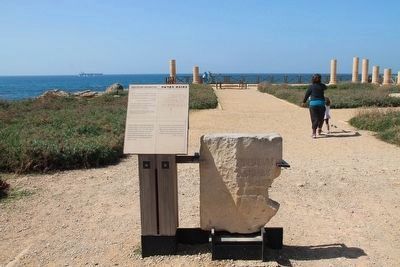
Photographed By Dale K. Benington, March 9, 2013
4. Dedicatory Inscription Marker
View of the marker, which is about the "Latin Dedicatory Inscription" stone, that is in the ancient port city of Caesarea Maritima, which is where the "Latin Dedicatory Inscription" stone was originally situated. This marker (which is called the "Dedicatory Inscription" marker) has an exact replica of the original inscribed cut stone.
Credits. This page was last revised on January 2, 2020. It was originally submitted on September 19, 2015, by Dale K. Benington of Toledo, Ohio. This page has been viewed 660 times since then and 7 times this year. Photos: 1, 2. submitted on September 20, 2015, by Dale K. Benington of Toledo, Ohio. 3, 4, 5, 6, 7. submitted on September 21, 2015, by Dale K. Benington of Toledo, Ohio. • Andrew Ruppenstein was the editor who published this page.
